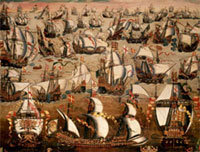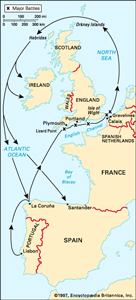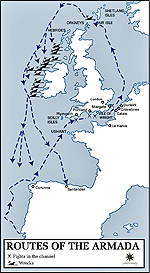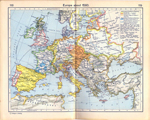|

The Spanish Armada
The Spanish Armada, also
called the Invincible Armada, was a fleet which was supposed to
invade England in 1588. King
 Philip II of Spain had it all
figured out.
Philip II of Spain had it all
figured out.
The Spanish plan was to avoid battle
until they had joined forces with the land army of Alessandro
Farnese, the duke of Parma, in Flanders, which is in today's Belgium. The Armada would shield these 30,000 troops from the
English fleet, so that they could safely cross the Channel from Flanders to
England.
But with bad weather conditions and the
English constantly so close on their heels, the Spaniards just couldn't pull
it off. Instead, they had to retreat north and sail back
home via Scotland and Ireland.
Vicious storms, diseases, and foot
shortages made the trip home the utter disaster.
Why Did Spain Want to
Invade England?
Spain was ready for war because Philip II was fed up with
a) the religion
in England not being Roman Catholic ever since
 Henry VIII broke
away from the Catholic Church in 1533, Henry VIII broke
away from the Catholic Church in 1533,
b) Protestant
 Elizabeth I in
general. Philip intended to put himself on the English throne
instead. Elizabeth I in
general. Philip intended to put himself on the English throne
instead.
c) England instigating Dutch rebels
against Spain, and
d) English pirates threatening Spanish
trades and commerce. And
 Sir Francis Drake,
vice-admiral of the English fleet, in particular being a severe
pain in the rear while he was plundering his way through the waters off the
homeland coast and overseas alike. Sir Francis Drake,
vice-admiral of the English fleet, in particular being a severe
pain in the rear while he was plundering his way through the waters off the
homeland coast and overseas alike.
 And thus, war between
England and Spain developed. And thus, war between
England and Spain developed.
Preparation and Launch
Ever since 1586, the Spanish
started working night and day to get their England invasion on its
way. Preparations were seriously delayed when Sir Francis Drake
popped up with a surprise attack on Cádiz in 1587.
In May 1588, Spain was ready and
launched its great Armada from Lisbon.
Elizabeth I went to Tilbury, gave her
 Spanish Armada
Speech and sent her troops on their way. Spanish Armada
Speech and sent her troops on their way.
Storms forced the fleet to
stay put at La Coruña until July. Finally, they reached Lizard Point
on July 29 (July 19, 1588, Old Style.)
The English fleet was at Plymouth and
followed the Armada up the Channel.
The first encounter was off Plymouth,
July 31 (July 21), the second off Portland Bill, August 2 (July 23),
the third off the Isle of Wight, August 4 (July 25). The Armada was
not seriously damaged and its formation remained intact.
On August 6 (July 27), the Armada had
reached the Strait of Dover and anchored off Calais. The same day,
the duke of Parma got his troops ready to leave Flanders and join
the Armada in Calais, a six day trip.
In the meantime, the Armada did the
sitting duck thing. All exposed, the English sneaked up on them in
the middle of the night on August 7/8 (July 28/29). The Spanish
ships scattered.
Taking advantage of the confusion, the
English finished the Armada off the next morning when they attacked
again off Gravelines. This was the naval
Battle of Gravelines, fought
on August 8, 1588.
The Spanish escaped northward and attempted to
sail home around Scotland and down the west coast of Ireland.
Vicious storms got the better of the
Armada. Spanish sailors who still had a boat ran out of provisions,
however. Those who landed in Ireland were killed by the English.
In late September the sad remnants of
the once Invincible Armada reached Spain. Only 60 ships of the
Spanish fleet made it home.
Spain lost about 15,000 men, England
several thousand men due to battle action and disease. Here are the
maps.

ROUTE OF THE SPANISH ARMADA
Click map to enlarge
The Leaders
Commander in chief of the Spanish Armada was Alonso Pérez de
Guzmán, duque de Medina Sidonia. Alonso was assigned to the job
following the death of the Marquess de Santa Cruz, who was Spain's
top admiral. In comparison, Alonso had little previous naval
experience. But the good man was loyal and courageous. So he didn't
flinch and off he went.
The English fleet was commanded by
Charles Howard, the Second Baron Howard of Effingham, who later
became the earl of Nottingham. His vice-admiral was Spanish
nightmare Sir Francis Drake.

1588 Routes of the Spanish Armada (USMA)
The Fleets in
Comparison
The Spanish Armada consisted of about 130 ships with about 8,000
seaman and 19,000 soldiers. About 40 of these ships were battle
ships.
The English fleet, consisting of about
130 ships, 40 of which being warships, followed the Armada up the
Channel. In comparison, the fleets were about the same size,
however, the English fleet was generally in better condition,
faster, and better armed.

1560 Europe
And here is a fine
 PDF Timeline of the Spanish Armada. PDF Timeline of the Spanish Armada.
More History
|